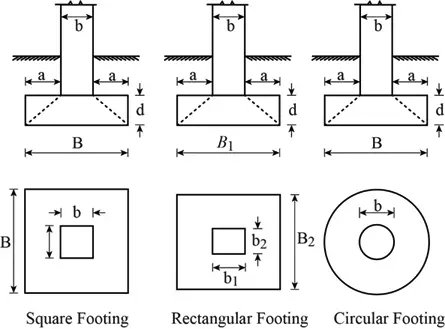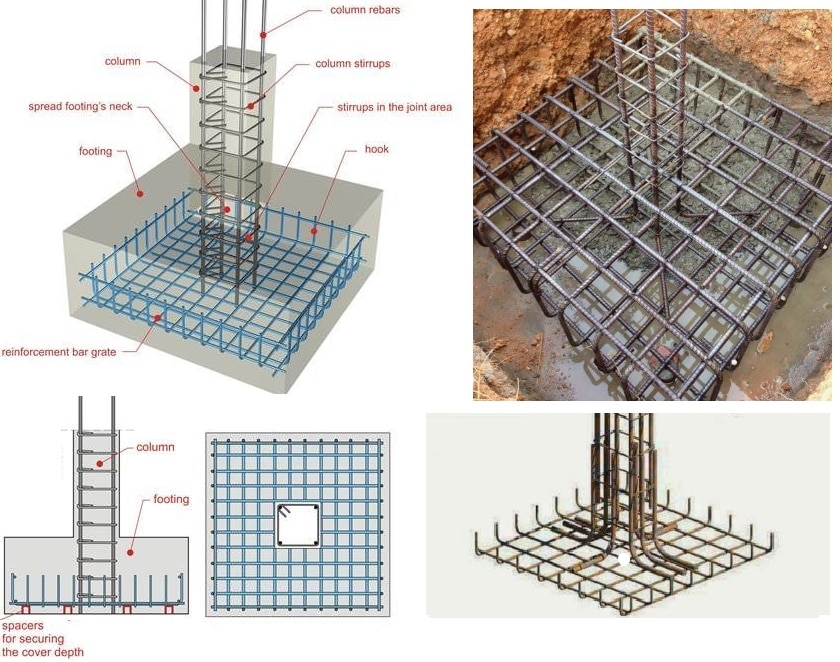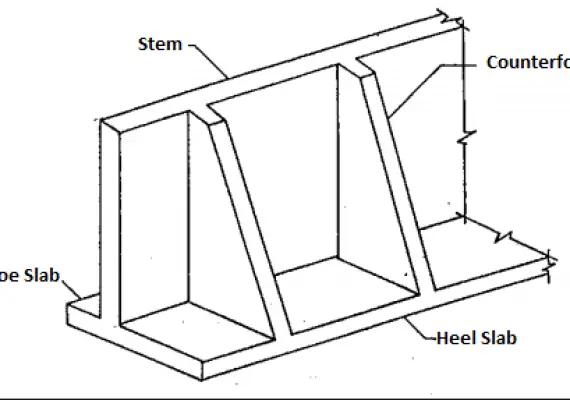Footing Size of the Column for 2 or 3 Storey House | Soil Load Capacity & Structural Load Capacity
Footing Size of the Column for 2 or 3 Storey House | Safe Bearing Capacity | How to Determine the Footing Size of a Building
Footing Size of the Column
What is the Footing Size of a Column?
In architecture, the footing size of a column is the length and width of the base or measure of the area in square feet that rests on the ground for the foundation. A lot of factors go into determining the footing size.
Footings are structural members that carry column or building loads to the soil beneath the structure. they designed to transmit these loads to the soil without exceeding its safe bearing capacity, to minimize settlement of the structure, to minimize differential settlement, and to prevent sliding and overturning.
The settlement is determined by the severity of the load, the kind of soil, and the foundation level. Where differential settlement is a possibility, the different footings should be designed in such a way that they settle independently of each other.
A soil analysis is used to determine the best type of foundation, and a structural design is used to estimate footing dimensions and the amount of reinforcement needed.
Because the soil’s compressive strength is often significantly lower than that of concrete, the contact area between the soil and the footing is much larger than that of the columns and walls.
In order to ascertain a column footing size for the construction of a particular building, the engineer must take into consideration a few things
Firstly, the size of the building is important. This might require the engineer to adjust the footing size in order to achieve an appropriate depth for the footing.
The type of soil on which the building is to be constructed is also taken into consideration. If the soil type is hard and compacted, then the engineer may choose a smaller footing size
A footing can be used for various reasons, such as to help support a building as it’s being built or to help support a building or other structure when there is no more ground to stand on.
As mentioned above, the size of a footing is determined by the size of the building or structure, and it can vary from as small as 2 square feet to as large as 1000 square feet.
The right size of the column footing is important because, if the footing is too small, the columns may not be able to support the weight they are meant to hold up.
If the footing is too large, it may waste money and space because it may take up more room than necessary while not supporting the weight it is supposed to. The size of the footing should be able to hold the weight it is needed.
NOTE: The footing size will depend on two things: One is the strength of the soil and two is the the weight of the building. The footing size is important because it transmits the load into the soil.
As a general rule, when the the bearing capacity of the soil is lower , the footing needs to be wider. When the soil is very strong, the footing must not be wide in order to hold the building up.
Footing Design
The following steps are commonly taken while designing a footing:
- Determine the footing requirements, including the loading and nature of the supported structure.
- Choose a footing arrangement and establish the soil specifications that are required. This stage is frequently accomplished with the assistance of a Geotechnical Engineer.
- The foundation shape is chosen such that any minimal requirements based on soil factors are met. The typical needs are as follows:
- Calculated bearing pressures must be lower than permitted bearing pressures. Bearing pressures are the forces exerted by the footing on the supporting soil. Bearing pressures are measured in pounds per square foot or other units of force per unit area.
- Due to applied loads, the calculated settlement of the footing must be less than the permitted settlement.
- The footing must be strong enough to withstand slide due to any horizontal loads.
- The footing must be stable enough to withstand overturning loads. Overturning loads are frequently created by horizontal loads placed above the footing’s base.
- The local conditions
- The requirements of the building code.
Types of Footing
The type of footing chosen for a particular structure is affected by the following:
- The bearing capacity of the underlying soil.
- The magnitude of the column loads.
- The position of the water table.
- The depth of foundations of adjacent buildings.
Footings may be classified as deep or shallow. If depth of the footing is equal to or greater than its width, it is called deep footing, otherwise it is called shallow footing.
Isolated Footing Design Example
An isolated footing is typically square or rectangular in shape and is used to sustain a single column’s load. It is the most basic, cost-effective, and widely used type of footing.
Square footings are used whenever possible to prevent bending moments and shearing stresses at important areas.
Isolated footings are adopted when the column loads are light, the columns are not tightly spaced, and the soil is uniform. The footing bends in a dish shape as a result of upward soil pressure.
An isolated footing must thus be provided by two sets of reinforcement bars arranged one on top of the other towards the footing’s bottom. In the case of property line limits, footings may be constructed for eccentric loads, or mixed footing may be used instead of separate footing.
Footing Width and Thickness
The footing width and thickness of a foundation is determined by the type of soil, depth of foundation, load requirements and driving cost.
The footing width should be at least 3 times the width of the wall or at least 3 feet (0.914 meters). The footing thickness should be at least 2 to 3 times the wall height or 2 to 3 feet (0.61 meters).
When a foundation is being built, there are many things to take into consideration. The footing width and thickness, for instance, are figured by considering soil type, depth of foundation and load requirements.
Depth of Footing
The depth to which foundations must be carried must meet the following requirements:
- Ensuring sufficient bearing strength.
- In the case of clay soils, footings must penetrate below the zone where seasonal weather fluctuations are likely to cause significant displacement.
- The footing should be positioned adequately below the maximum scouring depth.
- The footing should be located away from organic-containing top soils.
- The footing should be located away from uncemented materials such as trash.
All footings must reach at least 0.50 meter below natural ground level. Removal of the top soil may be all that is required on rocks or other weather-resistant natural ground.
In such circumstances, the surface must be cleaned so that a suitable bearing may be provided. Footings are often installed 1.5 to 2.0 meters below normal earth’s surface.
Soil Load Capacity and Structural Load Capacity
When considering footing specifications, it is critical to consider the structural load supported by each isolated post, as well as the soil’s load-bearing capacity.
When determining the structural weight of each post, the dead weight of the structure must be mixed with the predicted live load as well as the potential snow load.
The overall structural load (including dead, living, and snow weight) must be distributed across a broad soil surface using a footing so that the pounds per square foot at the footing’s base do not exceed the soil capacity. When soil is overloaded, it falls away and the footing sinks.
Footings may be significantly bigger for bigger structures, such as multi-story apartment complexes. Again, individual column footings and larger spread footings may be used for buildings built with a steel or concrete column and beam skeleton.
Buildings in earthquake regions or on less stable soil may have larger footings to counterbalanced forces that could be expected to act on the building structure.
In some areas where extreme seismic conditions must be mitigated other types of foundations such as helical piles, concrete piling, gravel piling, and many others are available.
Many buildings are also built “off-grade,” with piers and pier footings poured beneath them, or on timber piling, with pressure treated poles driven deep into the ground and supporting the building like stilts.
Maximum Soil Safe Bearing Capacity (SBC)of Different Types of Soils
The maximum load per unit area of soil is defined as its Soil bearing capacity. It is the ability of soil to withstand loads applied to it. S
oil bearing capacity is defined as the highest typical contact pressure between the foundation and the soil that will not cause shear failure in the soil.
The theoretical maximum pressure that can be borne without failure is known as load carrying capacity.
Large settlements may occur under overloaded foundations on soft soil locations without actual shear failure; in such circumstances, the acceptable bearing capacity is based on the maximum allowable settlement.
Bearing capacity is limited by three types of failure: general shear failure, local shear failure, and punching shear failure. It is determined by the shear strength of the soil as well as the shape, size, depth, and kind of foundation.
The maximum carrying capacity of soil is shown in the table. You get the maximum safe bearing capacity of soil for foundation design by dividing the maximum soil bearing capacity by a safety factor.
Maximum Soil Bearing Capacity (SBC)of Different Types of Soils
| Types of Foundation Soil | Soil Bearing Capacity (SBC) (kN/m2) |
| Soft, wet clay or muddy clay | 50 |
| Fine, loose and dry sand, soft clay | 100 |
| Moist clay and sand clay Mixture, Black cotton soil | 150 |
| Medium, compact, dry sand, medium clay, Loose gravel | 250 |
| Compact clay, soft rocks, Sand, gravel | 450 |
| Laminated rock such as sand stone & Lime stone | 1650 |
| Hard rocks such as granite, diorite, trap | 3300 |
Determining Bearing Capacity on Site
Using a hand penetrometer, you may get a reasonable estimate of the soil bearing capacity in the excavation base. This pocket-sized gadget is a spring-loaded probe that measures the soil’s resistance to pressure and is calibrated to give values in tons per square foot.
Every contractor and construction assessor, in my opinion, should have one of these; it can save you a lot of hassle.
How do I Determine the Footing Size of a Building?
The size of the footing will depend on the size and weight of the building and the amount of weight the soil can safely handle/ maximum bearing capacity.
Formula for Determining Footing Size
By knowing two things: 1) Weight on the footing 2) Load capacity of the soil, you can determine the footing size needed to support the load by using this formula:
A = B/C
Where A = Surface area of the footing
B = Load on the footing in pounds
C = Load carrying capacity of the soil in pounds per square foot (psf)
The area of the footing can be calculated as follows: Area Of Footing = Load on Footing (Total Load on the Columns)/SBC of soil.
What Is the Size of a Two- Three-Story Building’s Footing?
The dimensions are determined by three basic parameters, structural weight, number of columns and safe bearing capacity, all of which contribute to the number of weight/forces that the footing must withstand in order to make the building structurally sound.
The solution is a reasonable estimate of 2.0 meters x 2.0 meters isolated footing.
The main criteria here is the soil’s Safe Bearing Capacity (SBC).
A 2-metre x 2-meter footing is enough for a load of 300KN/floor and an SBC of 250KN/SqM. In general, dimensions ranging from 1.5m x 1.5m to 2.0m x 2.0m are appropriate.
Second, there will be an ultimate effect to the column. This is determined by elements such as the style of structure, such as walls, the type of occupancy for live loads, the intensity of dead loads, and, most importantly, the span of beams (spacing of columns).
Thickness of footing shall be based on three criteria. The first is the bending moment, secondly is one way shear and lastly punching shear.
Foundation Depth For 2 Storey Building/ Concrete Footing Size Rule Of Thumb
There are many factors to consider when it comes to foundation depth. Such factors can include: the site, the soil, the type of foundation, and the possible future construction of the building. Typically, a 2 storey building will require between 1.2 meters deep of foundation depth.
Footing depth for a two-story house or a modest two-story building, as a rule of thumb rule, using standard 9-inch-thick walls, the suggested depth of footing is at least 4 feet (1.2 meters) below ground level for isolated footing.
Shallow foundation in gravel and sand soil with increased bearing capacity and footing size of 1.2 meters x 1.2 meters
Footing Size for 3 Storey House Video



